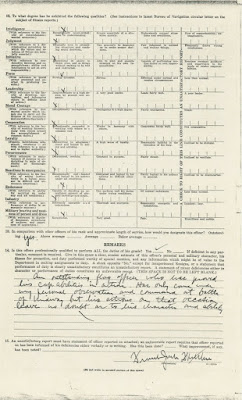Grading RADM Spruance's Performance at the Battle of Midway
Routine administrative paperwork rarely makes for
interesting reading. On occasion, though, the documents generated by Navy
bureaucracy can be illuminating, especially when they are associated with
important historical events. In honor of the anniversary of the Battle of
Midway, today's highlight is the officer fitness report that was filed for
Admiral Raymond Spruance following the events of June 4-7, 1942.
Two of the three carriers that participated in the battle,
USS Enterprise (CV-6) and USS Hornet (CV-8), together comprised Task
Force 16. Veterans of the Doolittle raid as well as smaller raids on Japanese
held islands in the Pacific, its commander was Vice Admiral William Halsey. In
late May 1942, Halsey contracted shingles and was forced to turn over his
command while he recovered. The head of the Pacific Fleet, Admiral Chester
Nimitz, asked him who should take over in his absence. Halsey had anticipated
this question and handed over a letter recommending Spruance due to his
outstanding performance as the commander of TF 16’s cruiser division. The two
had become close friends despite their contrasting command styles – Halsey was
outgoing and aggressive in battle while Spruance’s demeanor was quiet and
reflective even under the stress of war. Now Spruance got the nod to lead TF 16
in combat.
Spruance’s boss during the Battle of Midway, Admiral Frank
J. Fletcher, was also new to carrier operations, having commanded cruisers and
battleships for most of his career. Luckily for both, they inherited experienced
staffs who took care of flight operations, leaving them free to concentrate on
making critical decisions. In Spruance’s case, his most valuable aid was
Halsey’s chief of staff, Captain Miles Browning. Having earned his wings in
1924, Browning served Spruance well and advised him on all aviation matters.
The two did have disagreements during the battle, however, and there were
several instances when Spruance overruled him.
The most important example of this occurred at 7:45 AM on
June 4 as the initial strikes were getting airborne. Spruance ordered the dive
bombers that had launched first to proceed on their mission without waiting for
the torpedo bombers that comprised the rest of the attack wave. Enterprise had
intercepted a radio transmission from a Japanese scout plane indicating that TF
16 had been sighted, and Spruance did not want to delay his own attack. He
changed the plan and sent the dive bombers on their way. This decision allowed
them to save just enough fuel to conduct a search at the end of their flight
which resulted in locating the Japanese carriers Kaga and Akagi.
Fitness
report filed for RADM Raymond A. Spruance on August 14, 1942
Courtesy of the Naval Historical Collection, U.S. Naval War College
(click to enlarge)
In mid-August, Fletcher completed his assessment of
Spruance’s performance as a commander. After noting that Spruance’s flagship
was “operating with a major task force of the Pacific Fleet under conditions of
war,” Fletcher went on to rate Spruance a perfect 4/4 in his present assignment
and a 3.9/4 for ability to command. His remarks convey fully but succinctly the
depth of his respect for Spruance: “An outstanding flag officer who has proved
his capabilities in action. Has only come under my personal observation and
command at Battle of Midway but his actions on that occasion leave no doubt as
to his character and ability.”
Spruance's and Halsey’s careers remained closely connected,
each experiencing triumph and the sting of criticism in the years that
followed. Spruance went on to command Fifth Fleet and presided over The Battle
of the Philippine Sea which resulted in the destruction of most of Japan's remaining carrier aircraft. Much of the surface fleet escaped,
however, leading some to suggest that Spruance had been too timid when presented
with a golden opportunity. Likewise, Halsey finally got his chance to command
in a pivotal battle when his carriers participated in the Battle of Leyte Gulf.
Though his pilots sank four Japanese carriers, he was criticized for leaving
the American invasion fleet in the Philippines nearly defenseless while he
chased what turned out to be a decoy force far to the north. Nevertheless, both
men survived the war and received honors for their roles in helping to win it.
Halsey was promoted to Fleet Admiral in December 1945 and remains the most
recent officer to hold that rank. Spruance served as the twenty-sixth President
of the Naval War College, with his term running from March 1946 until his
retirement in July 1948.
Rob Doane
Curator
Naval War College Museum




Spruance and his boss, Fletcher, were prudent in keeping their task forces at close to the extreme range limit for the Japanese. The "experienced staffs who took care of flight operations" did well, but only about 2/3 of the time. Interesting that all three torpedo bomber squadrons found the Japanese Fleet with ease, while none of the dive bomber squadrons did until the Enterprise CAG, McCluskey, made a lucky guess as to which direction to fly with their remaining fuel. Hornet's aviators (except for their torpedo squadron) were badly served by two highly-regarded air officers, Captain Marc Mitscher and CAG, Cdr Stanhope Ring. Hornet's dive bombers never found the enemy and many were lost attempting to return to their ship. The torpedo squadron commander disregarded the assigned course and found the enemy, only to be totally destroyed by the Japanese fighter screen. Midway was a very interesting engagement with many lessons for naval scholars.
ReplyDelete